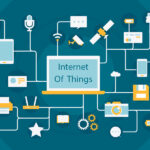Introduction of Edge Computing:
In the rapidly advancing world of technology, the title “Edge of Tomorrow: Revolutionizing Connectivity with Edge Computing Solutions” sets the stage for an exploration of the cutting-edge field of edge computing. This introduction aims to pique the reader’s interest by hinting at the transformative nature of edge solutions in reshaping connectivity.
Understanding Edge Computing:

This section provides a thorough breakdown of what edge computing is and how it differs from traditional cloud computing. It explores the concept of processing data closer to the source rather than relying on centralized cloud servers. The importance of reducing latency and improving real-time processing capabilities is emphasized, laying the foundation for the subsequent discussion.
What is Edge Computing:
At its core, edge computing is a paradigm in information technology where data is processed near the source of generation, rather than relying on a centralized cloud server. In traditional cloud computing, data is sent to a centralized data center for processing and analysis. However, edge computing takes a decentralized approach, processing data locally on devices or on servers located closer to the data source.
Here are some key aspects:
- Proximity to Data Source: The main principle of edge computing is to reduce latency by processing data as close as possible to where it is generated. This is particularly crucial for applications that require real-time processing, such as IoT devices, autonomous vehicles, and augmented reality.
- Decentralized Architecture: Unlike cloud computing, which relies on centralized servers, edge computing distributes the processing workload across multiple devices and servers. This decentralized architecture improves efficiency and reduces the need for continuous data transfers to a central location.
- Edge Devices: These are the devices that generate data at the edge of the network. Examples include sensors, IoT devices, and smartphones. Edge devices play a crucial role in collecting and transmitting data to be processed locally.
- Edge Computing Infrastructure: This includes the servers, gateways, and other computing resources located at the edge of the network. These components facilitate the processing and analysis of data locally, providing a more responsive and efficient computing environment.
- Edge Analytics: The capability to perform analytics and extract meaningful insights from data at the edge. This real-time analysis enables quicker decision-making and is especially important in applications where timely responses are critical.
Why Edge Computing?
- Reduced Latency: By processing data closer to the source, edge computing minimizes the time it takes for data to travel between devices and servers, resulting in lower latency.
- Bandwidth Optimization: Edge computing reduces the need for continuous data transfers to centralized servers, optimizing bandwidth usage and improving overall network efficiency.
- Improved Security: Processing sensitive data locally can enhance security by reducing the exposure of data during transit to centralized servers.
- Real-time Decision Making: Applications that require immediate responses, such as autonomous vehicles or industrial automation, benefit from the real-time processing capabilities of edge computing.
Evolution of Connectivity:
Trace the historical evolution of connectivity, highlighting key milestones that led to the need for more efficient and faster solutions. Explore the shift from centralized computing models to the distributed and decentralized nature of edge computing, showcasing its relevance in the context of an increasingly interconnected world.
Key Components of Edge Computing Solutions:
Break down the components that make up an edge computing ecosystem. Explore the role of edge devices, such as sensors and IoT devices, in collecting data. Discuss the infrastructure that enables edge computing, including edge servers and gateways. Dive into the significance of edge analytics in processing data at the edge and extracting actionable insights.
Advantages of Edge Computing(E C):
Examine the advantages that make E C a game-changer in the tech landscape:
- Low Latency: Explore how edge computing minimizes the delay in data processing, crucial for applications requiring real-time responsiveness like autonomous vehicles and augmented reality.
- Bandwidth Efficiency: Discuss how edge solutions optimize bandwidth usage by processing data locally, reducing the need for continuous data transfers to centralized servers.
- Improved Security: Highlight the enhanced security achieved by processing sensitive data closer to the source, reducing the risk of data breaches during transit.
- Real-time Decision Making: Illustrate how the ability to process and act on data in real-time enables faster decision-making, critical for applications in healthcare, finance, and more.
Industries Transforming with Edge Computing:
Explore specific industries that are leveraging edge computing to revolutionize their operations:
- Healthcare: Discuss how E C is enhancing patient care through real-time monitoring, remote diagnostics, and personalized treatment plans.
- Manufacturing: Explore the role of edge solutions in optimizing production processes, reducing downtime, and enabling predictive maintenance.
- Retail: Highlight the use of E C in improving customer experiences, inventory management, and personalized marketing strategies.
- Smart Cities: Discuss the implementation of edge technologies in creating efficient urban infrastructure, from traffic management to energy distribution.
Case Studies:
Provide real-world examples to illustrate the practical applications of E C :
- Smart Homes: Explore how edge devices in smart homes, such as smart thermostats and security systems, enhance automation and responsiveness.
- Autonomous Vehicles: Discuss how edge computing enables real-time decision-making in autonomous vehicles, ensuring safety and efficiency on the roads.
- Industrial IoT: Showcase how edge solutions in industrial settings enhance predictive maintenance, monitor equipment health, and optimize manufacturing processes.
Challenges and Solutions:
Address the common challenges associated with edge computing and propose solutions:
- Security Concerns: Discuss the potential vulnerabilities and how encryption, secure protocols, and decentralized architectures address security issues.
- Scalability: Explore strategies for scaling E C solutions, including edge cloud integration and the use of edge orchestration platforms.
- Standardization: Discuss the importance of industry-wide standards to ensure interoperability and seamless integration of diverse edge devices and systems.
Future Trends in Edge Computing(EC):
Peek into the future of edge computing:
- Edge AI Integration: Explore how the integration of artificial intelligence at the edge will enable more advanced and autonomous decision-making.
- 6G and E C: Discuss the synergies between 6G networks and E C, anticipating faster and more reliable connectivity.
- Edge-to-Cloud Collaboration: Explore the evolving relationship between edge and cloud computing, envisioning a collaborative approach for optimal data processing.
Conclusion:
Summarize the key takeaways from the exploration of . Emphasize the revolutionary impact it has on connectivity, shaping a future where real-time processing, efficiency, and decentralization play pivotal roles.
FAQs:
- What is edge computing
- Answer: E C is a paradigm that involves processing data closer to the source of generation, reducing latency, and enabling real-time decision-making.
- How does EC differ from cloud computing?
- Answer: While cloud computing relies on centralized servers for data processing, edge computing processes data locally, closer to the devices generating the data.
- What are the key components EC Solutions?
- Answer: Edge devices (sensors, IoT devices), EC infrastructure (servers, gateways), and edge analytics are key components.
- How does E C improve security?
- Answer: E C enhances security by processing sensitive data locally, reducing the risk of data breaches during transit to centralized servers.
- In which industries is E C making a significant impact?
- Answer: E C is transforming industries such as healthcare, manufacturing, retail, and smart cities through improved efficiency and real-time processing.
- What are the challenges associated with E C ?
- Answer: Challenges include security concerns, scalability issues, and the need for standardization. Solutions involve encryption, scalable architectures, and industry-wide standards.
- What are the future trends in E C ?
- Answer: Future trends include the integration of edge AI, collaboration with 6G networks, and a symbiotic relationship between edge and cloud computing.
Check out this post. Click Here









1 thought on “Edge of Tomorrow: Revolutionizing Connectivity with Edge Computing Solutions”